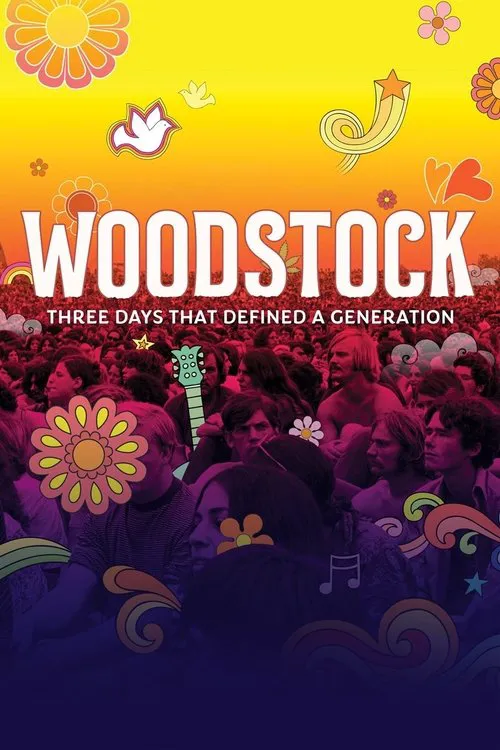Woodstock: Three Days That Defined a Generation

Plot
In August 1969, a cultural phenomenon swept across the United States, forever changing the landscape of music, social activism, and American counterculture. Woodstock Music & Art Fair, colloquially referred to as Woodstock, was a three-day concert held on a dairy farm in New York's Sullivan County. The event drew a crowd of over 400,000 young people from all corners of the country, united by their desire for peace, love, and music. Director Barak Goodman's Woodstock: Three Days That Defined a Generation, released 50 years after the iconic festival, offers a visceral and immersive retelling of the events through the voices of those who experienced it firsthand. Woodstock was the brainchild of four friends – John P. Roberts, Joel Rosenman, Artie Kornfeld, and Michael Lang – who came together to create a music festival that would showcase the talents of emerging artists and provide a platform for social activism. They envisioned a gathering of like-minded individuals who shared a passion for music, peace, and social justice. The dairy farm, nestled in a picturesque valley, was chosen for its vast open spaces, tranquil atmosphere, and proximity to the nearby town of Bethel. As the summer of '69 approached, excitement and anticipation grew among the music and festival communities. Artists from across the United States, including Jimi Hendrix, Janis Joplin, and Crosby, Stills, Nash & Young, were invited to perform at the festival. The lineup was a reflection of the era's musical diversity, featuring psychedelic rock, folk, blues, and other genres that resonated with the young and the restless. In the days leading up to the festival, however, concerns began to arise. Organizers underestimated the massive scale of the event, and preparations were rushed and incomplete. A severe downpour threatened to turn the grounds into a muddy mess. Despite these challenges, the festival's spirit remained unbroken, and an estimated 200,000 people arrived on the site on the opening day, August 15. Many more poured in over the next two days, forcing the crowds to spill over onto surrounding roads and neighboring towns. The music, however, was the central focus of the festival, and the performances did not disappoint. Jimi Hendrix electrified the stage with his iconic set, including the legendary performance of "The Star-Spangled Banner." Janis Joplin, known for her raw, soulful vocals, delivered several unforgettable performances. The Who and Joan Baez, among other notable acts, brought their unique energy to the festival. Woodstock: Three Days That Defined a Generation is built around the testimonies of attendees who were there to experience it all firsthand. Their stories humanize the festival, revealing a complex and multifaceted narrative that defies simplistic explanations. For many, Woodstock was a rite of passage, a moment of liberation from the restrictive social norms of the time. As one attendee recalls, "It was like a national coming-out party, where everyone just let their hair down and let go of all the pretenses." For others, Woodstock was a testament to the resilience and determination of a community united against the backdrop of an increasingly divisive Vietnam War and the oppressive policies of the time. Performances by folk singers Joan Baez and Arlo Guthrie became impromptu rallying cries against the war, as they used the festival as a platform for anti-war activism. The event itself became a powerful symbol of resistance, inspiring a generation to question authority and challenge the status quo. Goodman's directorial approach allows the audience to witness Woodstock through the eyes of those who lived it. We see the festival through the lens of a cameraman, the sounds of a DJ spinning records, and the faces of artists and attendees alike, all captured on film. Woodstock becomes a sensory experience, transporting viewers to a bygone era where music, peace, and love were the defining values of an entire generation. In many ways, Woodstock: Three Days That Defined a Generation serves as a love letter to that era, a nostalgic tribute to a moment in American history that continues to shape culture and politics today. The film is also a testament to the power of community, highlighting the importance of shared experiences in shaping collective identity and values. As one Woodstock veteran reflects, "It was a moment in time when we were all connected by something bigger than ourselves. We saw the possibility of something new and better." As the 50th anniversary of Woodstock comes to a close, Barak Goodman's documentary reminds us that the spirit of the festival – that blend of freedom, passion, community, and joy – remains a vital part of our collective heritage. In a world increasingly fragmented and cynical, the ideals expressed at Woodstock stand as a testament to the enduring power of idealism, art, and human connection.
Reviews
Recommendations




